1995 CHEVROLET TRACKER light
[x] Cancel search: lightPage 113 of 354
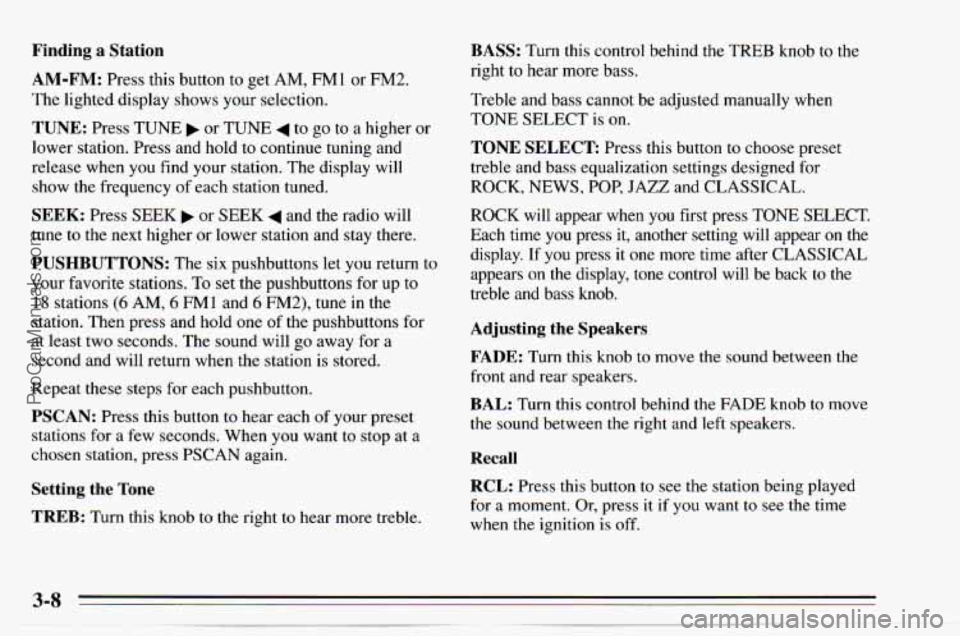
Finding a Station
AM-FM: Press this button to get AM, FM1 or FM2.
The lighted display shows your selection.
TUNE: Press TUNE or TUNE 4 to go to a higher or
lower station. Press and hold to continue tuning and
release when you find your station. The display will
show the frequency of each station tuned.
SEEK: Press SEEK or SEEK 4 and the radio will
tune to the next higher or lower station and stay there.
PUSHBUTTONS: The six pushbuttons let you return to
your favorite stations. To set the pushbuttons for up to
18 stations (6 AM, 6 FMl and 6 FM2), tune in the
station. Then press and hold one
of the pushbuttons for
at least two seconds. The sound will go away for a
second and will return when the station is stored.
Repeat these steps for each pushbutton.
PSCAN: Press this button to hear each of your preset
stations for a few seconds. When you want to stop at a
chosen station, press PSCAN again.
Setting the Tone
TREB: Turn this knob to the right to hear more treble.
BASS: Turn this control behind the TREB knob to the
right to hear more
bass.
Treble and bass cannot be adjusted manually when
TONE SELECT is on.
TONE SELECT Press this button to choose preset
treble and bass equalization settings designed for
ROCK, NEWS, POP, JAZZ and CLASSICAL.
ROCK will appear when you first press TONE SELECT.
Each time you press it, another setting will appear on the
display. If
you press it one more time after CLASSICAL
appears on the display, tone control will be back to the
treble and bass knob.
Adjusting the Speakers
FADE:
Turn this knob to move the sound between the
front and rear speakers.
BAL: Turn this control behind the FADE knob to move
the sound between the right and left speakers.
Recall
RCL: Press this button to see the station being played
for a moment. Or, press
it if vou want to see 2 time
when the ignition is off.
ProCarManuals.com
Page 114 of 354
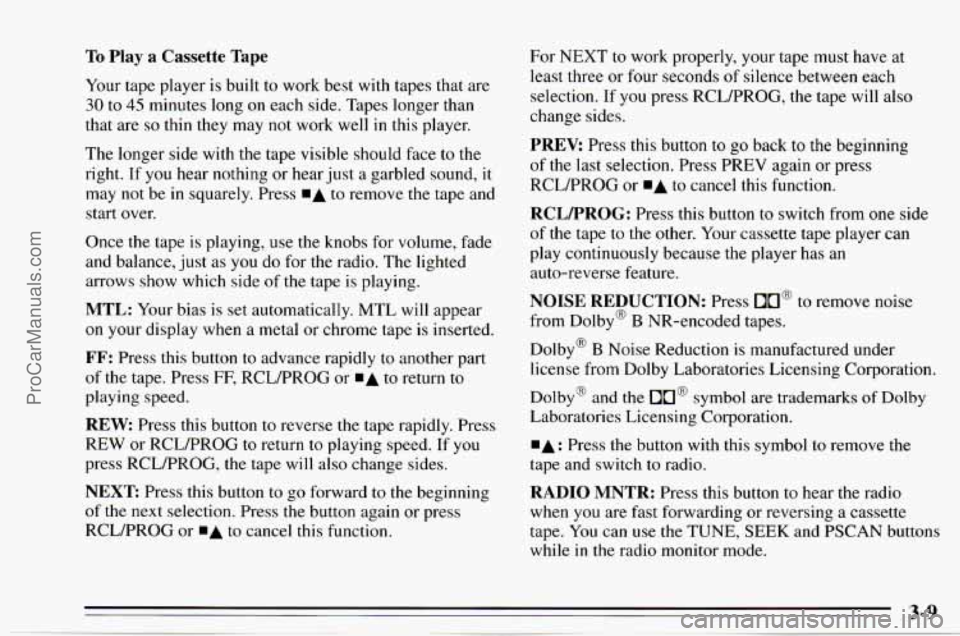
To Play a Cassette Tape
Your tape player is built to work best with tapes that are
30 to 45 minutes long on each side. Tapes longer than
that are
so thin they may not work well in this player.
The longer
side with the tape visible should face to the
right. If you hear nothing or hear just a garbled sound,
it
may not be in squarely. Press HA to remove the tape and
start over.
Once the tape is playing, use the knobs for volume, fade
and balance, just as you do
for the radio. The lighted
arrows show which side
of the tape is playing.
MTL: Your bias is set automatically. MTL will appear
on your display when a metal or chrome tape
is inserted.
FF: Press this button to advance rapidly to another part
of the tape. Press FF, RCLPROG or mA to return to
playing speed.
REW: Press this button to reverse the tape rapidly. Press
REW or RCL/PROG to return to playing speed. If you
press RCL/PROG, the tape
will also change sides.
NEXT Press this button to go forward to the beginning
of the next selection. Press the button again or press
RCLRROG or
mA to cancel this function. For
NEXT to
work properly, your tape must have at
least three
or four seconds of silence between each
selection. If you press RCL/PROG, the tape will also
change sides.
PREV: Press this button to go back to the beginning
of the last selection. Press PREV again or press
RCLPROG or WA to cancel this function.
RCLRROG: Press this button to switch from one side
of the tape to the other. Your cassette tape player can
play continuously because the player has an
auto-reverse feature.
NOISE REDUCTION: Press On@ to remove noise
from Dolby@
B NR-encoded tapes.
Dolby@
B Noise Reduction is manufactured under
license from Dolby Laboratories Licensing Corporation.
Dolby@ and the
c]o@ symbol are trademarks of Dolby
Laboratories Licensing Corporation.
WA: Press the button with this symbol to remove the
tape and switch to radio.
RADIO MNTR: Press this button to hear the radio
when you are fast forwarding or reversing a cassette
tape.
You can use the TUNE, SEEK and PSCAN buttons
while in the radio monitor mode.
ProCarManuals.com
Page 117 of 354
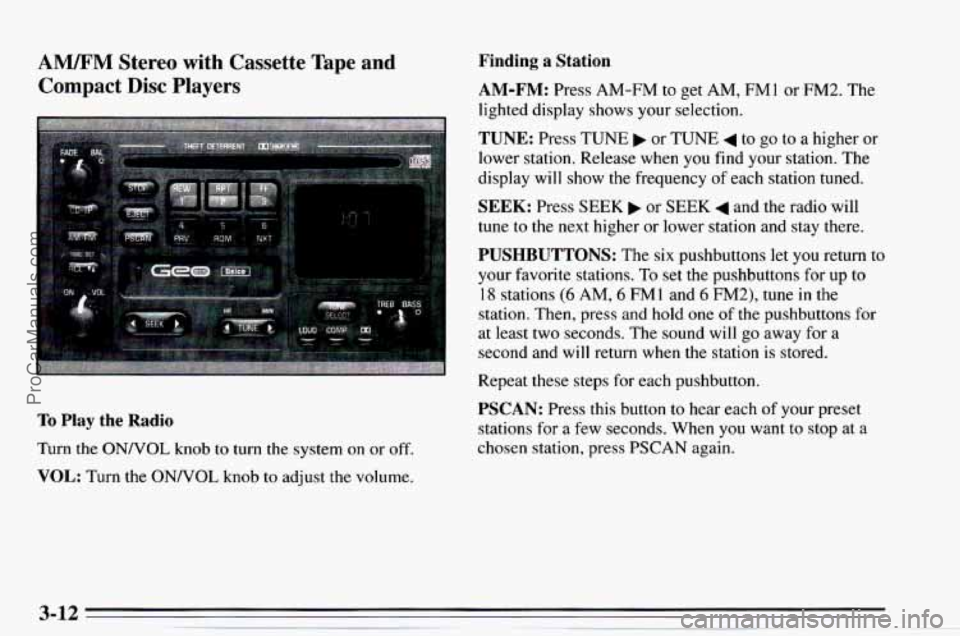
AM/FM Stereo with Cassette Tape and
Compact
Disc Players
To Play the Radio
Turn the ONNOL knob to turn the system on or off.
VOL: Turn the ONNOL knob to adjust the volume.
Finding a Station
AM-FM: Press AM-FM to get AM, FM 1 or FM2. The
lighted display shows your selection.
TUNE: Press TUNE b or TUNE 4 to go to a higher or
lower station. Release when
you find your station. The
display will show the frequency of each station tuned.
SEEK: Press SEEK b or SEEK 4 and the radio will
tune to the next higher or lower station and stay there.
PUSHBUTTONS: The six pushbuttons let you return to
your favorite stations. To set the pushbuttons for up to
18 stations (6 AM, 6 FM 1 and 6 FM2), tune in the
station. Then, press and hold one
of the pushbuttons for
at least two seconds.
The sound will go away for a
second and will return when the station is stored.
Repeat these steps for each pushbutton.
PSCAN: Press this button to hear each of your preset
stations for a few seconds. When you want to stop at a
chosen station, press PSCAN again.
ProCarManuals.com
Page 118 of 354

Setting the Tone To Play a Cassette Tape
Your tape player is built to work best with tapes that are
30 to 45 minutes long on each side. Tapes longer than
that are
so thin they may not work well in this player.
The longer side with the tape visible should face to the
right.
If you hear nothing or hear just a garbled sound, it
may not be in squarely. Press STOP or EJECT to
remove the tape
and start over.
TREB: Turn this knob to the right to hear more treble.
BASS: Turn this control behind the TREB knob to the
right
to hear more bass.
TONE SELECT Press this button to choose preset
treble and bass equalization settings designed for
ROCK, NEWS, POP, JAZZ and CLASSICAL.
ROCK will appear when you first press TONE SELECT.
Each time you press it, another setting will appear on the
display. If you press it one more
time after CLASSICAL
appears on
the display, tone control will be back to the
treble and bass
knob.
Adjusting the Speakers
FADE:
Turn this knob to move the sound between the
front and rear speakers.
BAL: Turn this control behind the FADE knob to move
the sound between the right and
left speakers.
Recall
RCL: Press RCL v A to see the station being played
for
a moment. Or, press it if you want to see the time
when the ignition is off. Once
the tape is playing,
use the knobs for volume, fade
and balance, just as you do for the radio. The lighted
arrows
show which side of the tape is playing.
MTL: Your bias is set automatically. MTL will appear
on the display
when a metal or chrome tape is inserted.
FF: Press this button to advance rapidly to another part
of the tape. Press
FF, RCL v A or STOP to return to
playing speed.
If you press RCL 7 A, the tape will also
change sides.
REW. Press this button to reverse the tape rapidly. Press
REW, RCL
v A or STOP to return to playing speed. If
you press RCL
A, the tape will also change sides.
NXT Press this button to go forward to the beginning of
the next selection. Press NXT again or press RCL v A
or STOP to cancel this function. If you press RCL v A,
the tape will also change sides.
8 3-13
- ~ ProCarManuals.com
Page 124 of 354
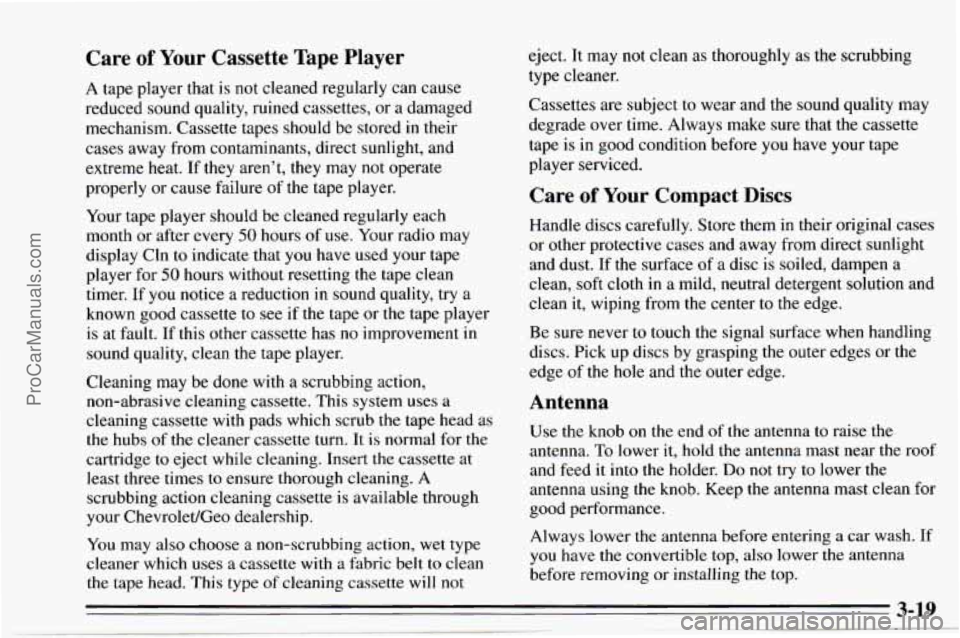
Care of Your Cassette Tape Player
A tape player that is not cleaned regularly can cause
reduced sound quality, ruined cassettes, or a damaged
mechanism. Cassette
tapes should be stored in their
cases away from contaminants, direct sunlight, and
extreme heat. If they aren’t, they
may not operate
properly or
cause failure of the tape player.
Your tape player should be cleaned regularly each
month or after every
50 hours of use. Your radio may
display Cln to indicate
that you have used your tape
player for
50 hours without resetting the tape clean
timer.
If you notice a reduction in sound quality, try a
known good cassette
to see if the tape or the tape player
is at fault. If this other cassette has no improvement in
sound quality, clean the tape player.
Cleaning may be done
with a scrubbing action,
non-abrasive cleaning cassette. This system uses a
cleaning cassette with pads which scrub
the tape head as
the hubs of the cleaner cassette turn. It is normal for the
cartridge to eject
while cleaning. Insert the cassette at
least three times to ensure thorough cleaning.
A
scrubbing action cleaning cassette is available through
your Chevrolet/Geo dealership.
You may also choose a non-scrubbing action, wet type
cleaner which uses a cassette
with a fabric belt to clean
the tape head. This type
of cleaning cassette will not eject.
It may not
clean as thoroughly as the scrubbing
type cleaner.
Cassettes
are subject to wear and the sound quality may
degrade over time. Always make sure that
the cassette
tape is in good condition before you have your tape
player serviced.
Care of Your Compact Discs
Handle discs carefully. Store them in their original cases
or other protective cases and away from direct sunlight
and dust. If
the surface of a disc is soiled, dampen a
clean, soft cloth
in a mild, neutral detergent solution and
clean it, wiping from the center to the edge.
Be sure never to touch the signal surface when handling
discs. Pick up discs by grasping the outer edges or the
edge of the hole and
the outer edge.
Antenna
Use the knob on the end of the antenna to raise the
antenna. To lower it, hold the antenna mast near the roof
and feed it into the holder.
Do not try to lower the
antenna using the knob. Keep the antenna mast clean for
good performance.
Always lower the antenna before entering a car wash. If
you have the convertible top, also lower the antenna
before removing
or installing the top.
ProCarManuals.com
Page 135 of 354
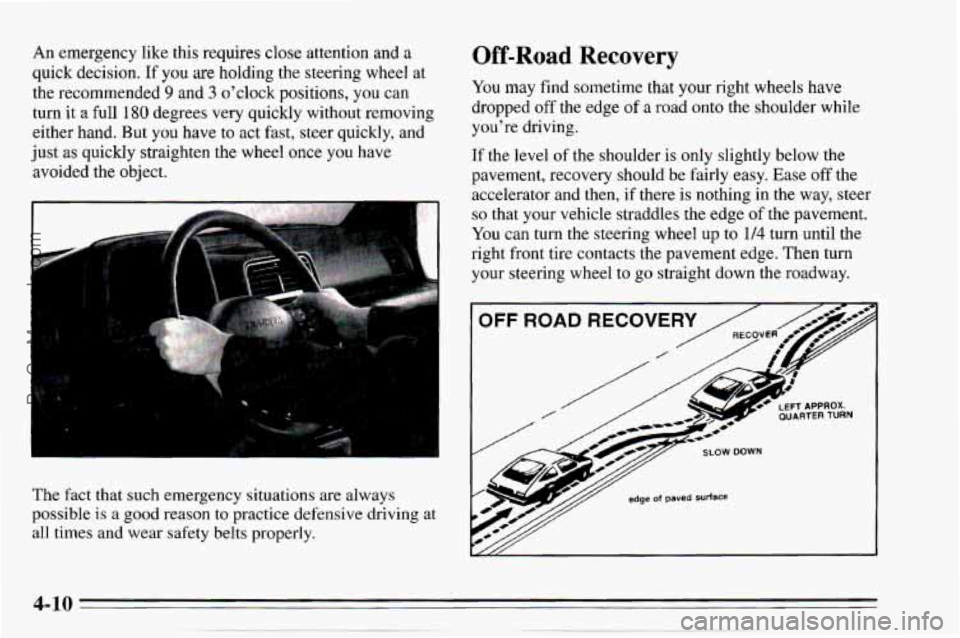
An emergency like this requires close attention and a
quick decision. If you are holding the steering wheel at
the recommended
9 and 3 o'clock positions, you can
turn it a full
180 degrees very quickly without removing
either hand. But you have to act fast, steer quickly, and
just
as quickly straighten the wheel once you have
avoided the object.
The fact that such emergency situations are always
possible
is a good reason to practice defensive driving at
all times and wear safety belts properly.
Off-Road Recovery
You may find sometime that your right wheels have
dropped
off the edge of a road onto the shoulder while
you're driving.
If the level of the shoulder is only slightly below the
pavement, recovery should be fairly easy. Ease
off the
accelerator and then,
if there is nothing in the way, steer
so that your vehicle straddles the edge of the pavement.
You can
turn the steering wheel up to 114 turn until the
right front tire contacts the pavement edge. Then turn
your steering wheel to
go straight down the roadway.
OFF ROAD RECOVERY
/
ProCarManuals.com
Page 142 of 354
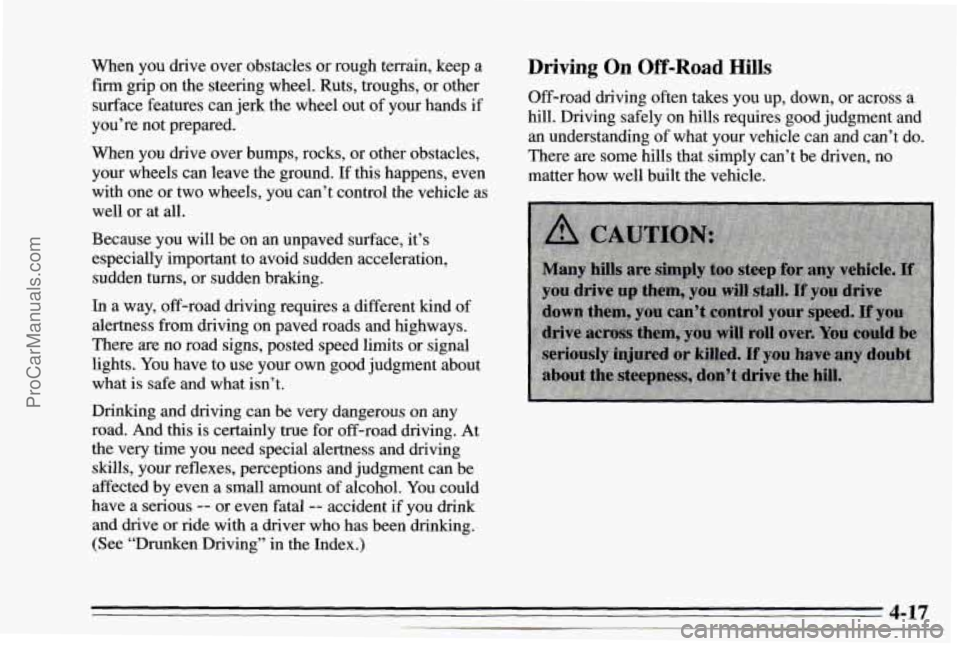
When you drive over obstacles or rough terrain, keep a
firm grip on the steering wheel. Ruts, troughs, or other
surface features can jerk the wheel out
of your hands if
you’re not prepared.
When you drive over bumps, rocks, or other obstacles,
your wheels can leave the ground.
If this happens, even
with one or two wheels, you can’t control the vehicle as
well or at all.
Because you will be on an unpaved surface, it’s
especially important to avoid sudden acceleration,
sudden turns,
or sudden braking.
In a way, off-road driving requires a different lund
of
alertness from driving on paved roads and highways.
There are no road signs, posted speed limits or signal
lights. You have to use your own good judgment about
what
is safe and what isn’t.
Drinking and driving can be very dangerous on any
road. And this
is certainly true for off-road driving. At
the very time you need special alertness and driving
skills, your reflexes, perceptions and judgment can be
affected by even a small amount
of alcohol. You could
have a serious
-- or even fatal -- accident if you drink
and drive or ride with a driver who has been drinking.
(See “Drunken Driving” in
the Index.)
Driving On Off-Road Hills
Off-road driving often takes you up, down, or across a
hill. Driving safely on hills requires good judgment and
an understanding
of what your vehicle can and can’t do.
There are some hills that simply can’t be driven, no
matter how well built the vehicle.
4-17
ProCarManuals.com
Page 150 of 354
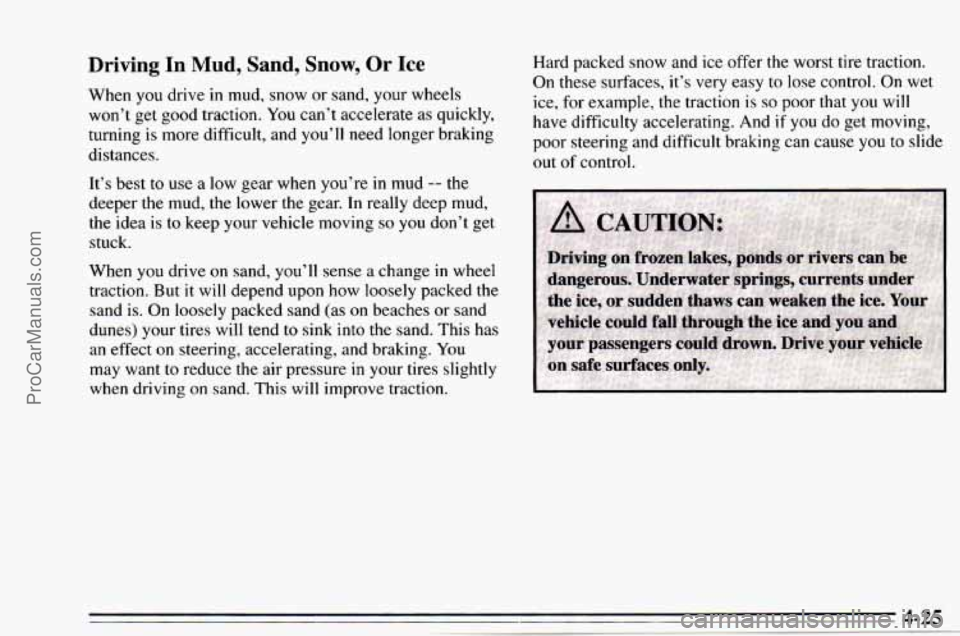
Driving In Mud, Sand, Snow, Or Ice
When you drive in mud, snow or sand, your wheels
won’t get good traction. You can’t accelerate as quickly,
turning
is more difficult, and you’ll need longer braking
distances.
It’s best to use a low gear when you’re
in mud -- the
deeper the mud, the lower the gear. In really deep mud,
the idea is to keep your vehicle moving
so you don’t get
stuck.
When you drive on sand, you’ll sense
a change in wheel
traction. But
it will depend upon how loosely packed the
sand is. On loosely packed sand (as on beaches or sand
dunes) your tires will tend to sink into the sand. This has
an effect on steering, accelerating, and braking. You
may want to reduce the air pressure
in your tires slightly
when driving on sand. This will improve traction. Hard
packed snow and ice offer the worst tire traction.
On these surfaces, it’s very easy to lose control. On wet
ice, for example, the traction is
so poor that you will
have difficulty accelerating. And if you do get moving,
poor steering and difficult braking can cause you to slide
out of control.
ProCarManuals.com